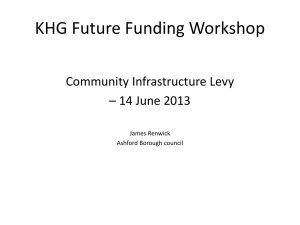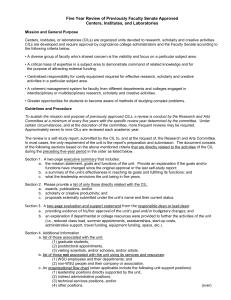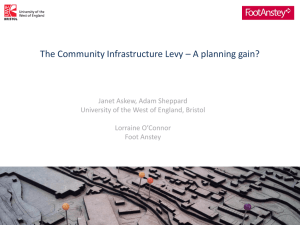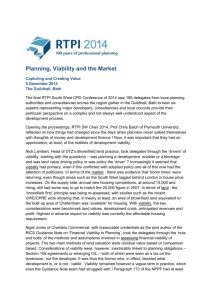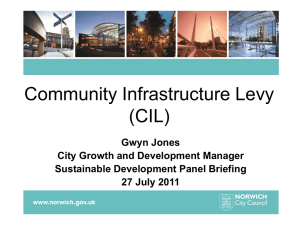Infrastructure Delivery Plan and the Existence of a Funding Gap
advertisement
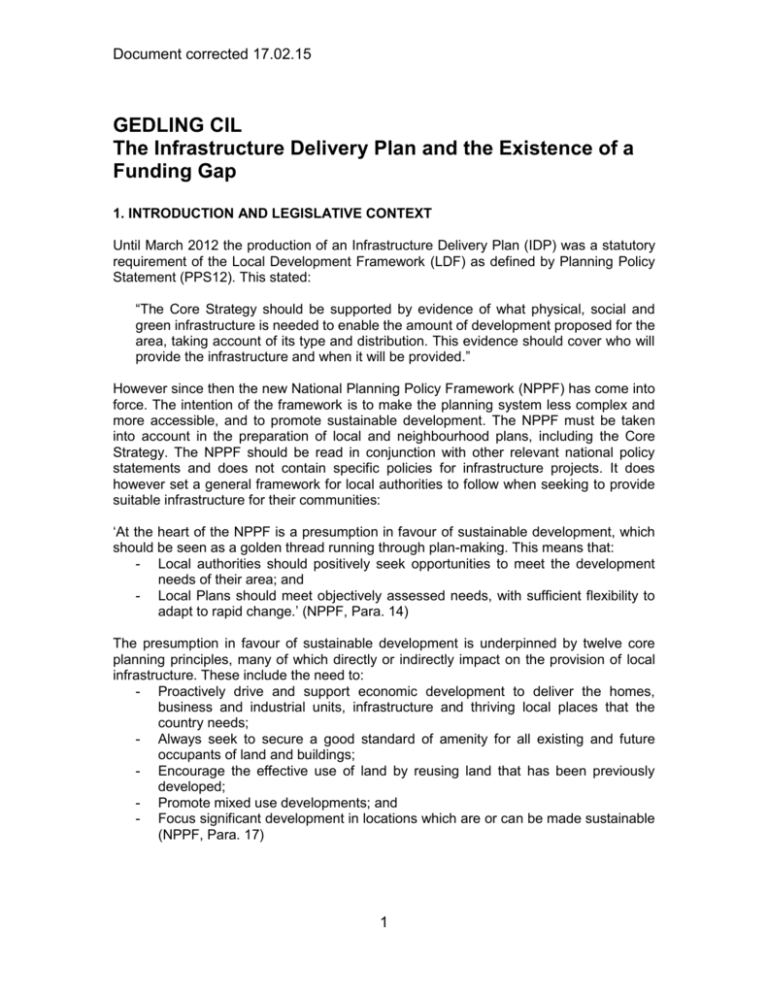
Document corrected 17.02.15 GEDLING CIL The Infrastructure Delivery Plan and the Existence of a Funding Gap 1. INTRODUCTION AND LEGISLATIVE CONTEXT Until March 2012 the production of an Infrastructure Delivery Plan (IDP) was a statutory requirement of the Local Development Framework (LDF) as defined by Planning Policy Statement (PPS12). This stated: “The Core Strategy should be supported by evidence of what physical, social and green infrastructure is needed to enable the amount of development proposed for the area, taking account of its type and distribution. This evidence should cover who will provide the infrastructure and when it will be provided.” However since then the new National Planning Policy Framework (NPPF) has come into force. The intention of the framework is to make the planning system less complex and more accessible, and to promote sustainable development. The NPPF must be taken into account in the preparation of local and neighbourhood plans, including the Core Strategy. The NPPF should be read in conjunction with other relevant national policy statements and does not contain specific policies for infrastructure projects. It does however set a general framework for local authorities to follow when seeking to provide suitable infrastructure for their communities: ‘At the heart of the NPPF is a presumption in favour of sustainable development, which should be seen as a golden thread running through plan-making. This means that: - Local authorities should positively seek opportunities to meet the development needs of their area; and - Local Plans should meet objectively assessed needs, with sufficient flexibility to adapt to rapid change.’ (NPPF, Para. 14) The presumption in favour of sustainable development is underpinned by twelve core planning principles, many of which directly or indirectly impact on the provision of local infrastructure. These include the need to: - Proactively drive and support economic development to deliver the homes, business and industrial units, infrastructure and thriving local places that the country needs; - Always seek to secure a good standard of amenity for all existing and future occupants of land and buildings; - Encourage the effective use of land by reusing land that has been previously developed; - Promote mixed use developments; and - Focus significant development in locations which are or can be made sustainable (NPPF, Para. 17) 1 Document corrected 17.02.15 The NPPF recognises that in promoting economic development there is only so much business can be required to contribute to the requirements of planning policy expectations and that a ‘clear economic vision’ must be developed of how growth is going to be achieved i.e. proposals must be realistically deliverable. It also notes that the absence of suitable infrastructure is a barrier to growth and that priorities for intervention must be highlighted: ‘Planning policies should recognise and seek to address barriers to investment, including a poor environment or any lack of infrastructure, services or housing. Local planning authorities should identify priority areas for economic regeneration, infrastructure provision and environmental enhancement.’ (NPPF, Para. 21) Therefore the need for a targeted and deliverable Infrastructure Delivery Plan remains a key element of local planning policy. In preparing such a plan the NPPF states: ‘Local planning authorities should work with other authorities and providers to: o Assess the quality and capacity of infrastructure for transport, water supply, wastewater and its treatment, energy (including heat), telecommunications, utilities, waste, health, social care, education, flood risk and coastal change management, and its ability to meet forecast demands; and o Take account of the need for strategic infrastructure including nationally significant infrastructure within their areas.’ (NPPF, Para. 162) Developing a Robust IDP With the strategic justification clear, it is imperative to focus on how local authorities and their partners produce an effective IDP. Good infrastructure planning should take into account the infrastructure required to support development, costs, sources of funding, timescales for delivery and gaps in funding. This allows for the identified infrastructure to be prioritised in discussions with key local partners. The infrastructure planning process should identify, as far as possible: o o o o Infrastructure needs and costs; Phasing of development; Funding sources; and Responsibilities for delivery. The IDP is an essential element of the evidence that supports the Core Strategy and other Development Plan Documents in the LDF. The IDP therefore responds to the growth targets and policies in the Core Strategy, elaborating on how the spatial objectives will be delivered through the provision of infrastructure. The purpose of an IDP is to help deliver an authority’s long-term vision for the future. It describes what infrastructure is needed and how, when and by whom it will be delivered and, where known, the location. It should be accompanied by an Infrastructure Delivery Schedule that presents the key programmes and projects that are important for the delivery of the Core Strategy. By infrastructure we mean physical or hard infrastructure such as utilities and transport; green infrastructure such as parks, open spaces and the natural environment; and social 2 Document corrected 17.02.15 infrastructure such as schools, health facilities and other public service centres. A full list of infrastructure to be included in an IDP is tabulated below. Table 1: Infrastructure Types Hard Infrastructure Green Infrastructure Social Infrastructure Economic Development ICT/Broadband Transport Utilities Allotments Green Links Natural Open Land Outdoor Sports Recreation Parks and Play Areas Arts, Libraries and Culture Indoor Sports and Leisure Education Health and Social Care Waste Processing Recycling and and River and Natural Water Features 3 Indoor Sports and Leisure Document corrected 17.02.15 2. CURRENT STATUS OF GEDLING IDP The Greater Nottingham Joint Planning Advisory Board (JPAB) oversees the preparation of Aligned Core Strategies across Greater Nottingham, and the implementation of the Growth Point infrastructure projects. The Greater Nottingham Growth Point Team has prepared a joint Infrastructure Capacity Study and Delivery Plan on behalf of Broxtowe, Erewash, Gedling, Nottingham and Rushcliffe Councils. As Hucknall (part of Ashfield District) forms part of Greater Nottingham and has a close functional relationship with the other council areas, the IDP has regard to cross boundary and cumulative infrastructure requirements across the whole of Greater Nottingham including Hucknall. The Growth Point Team in conjunction with Ashfield Council have made assumptions to enable impacts on, for example, transport networks and water resources to be more accurately assessed. Ashfield has prepare its own IDP in 2013 that includes details of growth and specific sites. The consultancy team preparing the Community Infrastructure Levy for Gedling Borough Council were provided with a copy of the Greater Nottingham Infrastructure Delivery Plan (version 1) dated June 2012. Since this time the figures have been refined and the latest schedule is derived from the Aligned Core Strategies Publication Version (March 2014) Minor amendments and main modifications; Appendices A & B (Ref CD/EX/10A) The IDP schedule covers the following categories of infrastructure: a) b) c) d) e) f) g) h) i) j) k) Transport (Highways, Public Transport, Air and Water) Utilities (Water, Energy, Digital Infrastructure) Flooding and Flood Risk Health Provision Education Provision Police Services Ambulance Services Fire Services Waste Management (Collection and Disposal) Community Services Green Infrastructure. 4 Document corrected 17.02.15 3. GEDLING INFRASTRUCTURE SCHEMES The Community Infrastructure Levy is intended to assist in filling the funding gap that remains once existing sources (to the extent that they are known) have been taken into account. It is important in justifying the charging of a Community Infrastructure Levy for Gedling that a funding gap be clearly demonstrated. If no gap exists the requirement for introducing the Levy in Gedling would come under scrutiny. The diagram below illustrates how the funding gap is established. Infrastructure Funding Gap Residual Funding Gap Projected CIL Income / CIL Target Aggregate Funding Gap Other Sources Total Cost of Infrastructure Funding Funding Table 2 includes those projects which have been identified in the IDP to date within Gedling. In addition two more local projects with Growth Point support have been listed. The projects are arranged in infrastructure categories. There are currently 23 schemes identified; 3 of which have no costs estimated as yet. The cost of implementing the remaining schemes totals £87m. Limited funding has been identified for the schemes that make up this total. Approximately £28m of costs will be incurred on schemes that are scheduled for delivery in the next 5 years. The table illustrates that there is currently a shortfall of £36m over the 15 year plan period The most costly scheme identified is for the access road to facilitate the development of the Gedling Colliery/Chase Farm site (£32.4m). The Local Transport Board has identified the road as a strategic priority and provisionally set aside a £10.8m contribution. In addition there is potential for a further £5.4m from Nottinghamshire County Council and £3m from the Public Land and Infrastructure Fund. £8m worth of funding for land purchase etc to facilitate the project had already been sourced via the HCA. CIL will 5 Document corrected 17.02.15 cover the remaining shortfall of £5.2m. Table 2 includes those projects which have been identified in the IDP to date within Gedling. In addition two more local projects with Growth Point support have been listed. The projects are arranged in infrastructure categories. There are currently 23 schemes identified; 3 of which have no costs estimated as yet. The cost of implementing the remaining schemes totals £88m. Limited funding has been identified for the schemes that make up this total. The table illustrates that there is currently a shortfall of £23m over the 15 year plan period The most costly scheme identified is for the access road to facilitate the development of the Gedling Colliery/Chase Farm site (£32.4m). The Local Transport Board has identified the road as a strategic priority and provisionally set aside a £10.8m contribution. In addition there is potential for a further £5.4m from Nottinghamshire County Council and £3m from the Public Land and Infrastructure Fund. £8m worth of funding for land purchase etc to facilitate the project had already been sourced via the HCA. CIL will cover the remaining shortfall of £6.2m. In respect of the remaining schemes the IDP for the Aligned Core Strategy identifies S.106 contributions as a major source of funding. In respect of the education infrastructure S.106 is listed as the only contributor. Nottingham County Council has been consulted in order to clarify the position and it has been confirmed that no County Council funding will be available for new school places required as a result of development and there is an expectation that developer contributions will fund these places. However the IDP was produced in the ‘non–CIL world’ and in practice education provision is likely to be from a combination of CIL and S.106. For example where there is a known requirement for a new school this could be identified in the Reg. 123 list, whereas all other improvements could be sought through S.106. This gives the ability to account for 'planned' growth, and also to react to 'unplanned' growth and ad hoc planning applications. Some S.106 contributions have been identified in Table 2 but this will change over time. All gaps in health expenditure are also identified as being funded through developer contributions It is anticipated that the Aligned Core Strategy will be adopted by the autumn 2014 in advance of the CIL Examination. If this is the case the CLG CIL guidance states that the CIL examiner will normally accept the data collated in the IDP as sufficient evidence of the aggregate infrastructure funding gap and the total target amount to be raised through CIL. 6 Document corrected 17.02.15 Table 2: Infrastructure Schedule - Gedling Borough Council Only Schemes £K Infrastructure Category Project Location Project Description Comments Estimated Cost Green Infrastructure Gedling Colliery Gedling Country Park - footpaths & drainage £250 - Visitor Centre Green Infrastructure Calverton Green Infrastructure North of Papplewick Lane Mitigation measures associated with prospective Sherwood Forest Special Protection Area 1.6ha Public Open Space and maintenance contribution Regeneration Arnold Town Centre - Improvements Arnold - Leisure Centre Extn Timescale Progress Funding (provisional) Funding Source Funding Gap tbc 0 £950 Growth Point tbc Gedling Colliery/ Chase Farm Gedling Access Road to facilitate development of Gedling Colliery/Chase Farm. Transport Top Wighay Farm Integrated transport package Masterplan underway Transport Gedling Colliery Integrated transport package Masterplan underway tbc Health Gedling Colliery Health Centre Masterplan underway £570 £570 PCT/Dev £0 Health Health Top Wighay Farm North of Papplewick Lane GP Surgery Local health centre Masterplan underway Planning Application Stage £950 £285 £950 PCT/Dev £285 PCT/Dev £0 £0 Education Education Bestwood Village Bestwood Village Possible new primary School Expansion of secondary places Masterplan finalised Masterplan finalised £3,500 £552 £3,500.00 Developer £552.00 Developer £0 £0 Education Calverton Possible expansion of existing schools or new Primary School may be required Masterplan finalised £3,500 £3,500.00 Developer £0 Education Education Calverton Gedling Colliery Expansion of secondary places Primary School Masterplan finalised Masterplan underway £2,000 £3,500 £2,000.00 Developer £3,500 Developer £0 £0 Education Gedling Colliery Secondary school places contribution Masterplan underway £1,689 £1,689 Developer £0 Education Ravenshead Expansion of secondary places Masterplan finalised £1,210 £1,210 Developer £0 Education Top Wighay Farm Primary School Masterplan underway £3,500 £3,500 Developer £0 Education Top Wighay Farm Secondary school places contribution Masterplan underway £2,816 £2,816 Developer £0 Education North of Papplewick Lane North of Papplewick Lane Cumulative non strategic sites Primary School £3,500 £3,500 Developer £0 £1,267 £1,267 Developer £0 Cumulative non strategic sites Secondary school places contribution Planning Application Stage Planning Application Stage To be determined via Local Planning Document To be determined via Local Planning Document Education Education Education Total Secondary school places contribution Primary school places contribution HCA LTB County Council PLIF Developer Transport £8,750 £7,000 £10,800 £5,400 £3,000 8,750 £6,200 Strategic integrated transport measures to be confirmed via transport modelling Strategic integrated transport measures to be confirmed via transport modelling Detailed requirements to be confirmed following further consultation with NHS Nottinghamshire PCT Detailed requirements to be confirmed by NHS Nottinghamshire PCT Detailed requirements to be confirmed following further consultation with NHS Nottinghamshire PCT £7,500 £8,600 £8,600 £64,989 £23,300 7 Indicative costs for education provided on basis of current multiplier. Detailed assessment not yet possible as delivery timescale outside of reliable timescale for pupil projection forecasts Indicative costs for education provided on basis of current multiplier. Detailed assessment not yet possible as delivery timescale outside of reliable timescale for pupil projection forecasts £7,500 £88,289 GBC and HCA reviewing long term delivery options for the scheme. Local Transport Board now recognises as astrategic priority. £0 tbc *Cumulative non strategic education site costs pro-rata-ed across each 5 year time period Source: Aligned Core Strategies Publication Version (March 2014) - Minor changes and main modifications Appendices A & B CD/EX/10A; Gedling Borough Council Site Viability - Details of assumptions used to inform viability assessments (as set out in Appendix L of CD/EX/35) CDEX60; Gedling Borough Council Planning Strategy Team Mitagation measures follow guidance within HRA Screening Record and guidance from Natural England tbc £950 Within 15 Years £1,000 To be developed as tbc part of Master planning work Masterplan underway tbc To be costed by tbc GBC Planning Application £32,400 Stage Within 10 years 0 £250 Growth Point £1,000 Within 5 years £5,366 £5,367 Indicative costs for education provided for school places generated for nonstrategic housing sites over the plan period on basis of current multiplier. Detailed requirements to be confirmed in parallel with DPDs and detailed site proposals Indicative costs for education provided for school places generated for nonstrategic housing sites over plan period on basis of current multiplier. Detailed requirements to be confirmed in parallel with DPDs and detailed site proposals £12,567 Document corrected 17.02.15 Table 2: Infrastructure by Category - Gedling Borough Council only schemes Summary Table Infrastructure Category Total No of Projects No of Eligible No of Costed Cost of Infrastructure Source Green Infrastructure 4 4 2 1,250,000 Growth Point Regeneration 2 2 2 950,000 Transport 3 3 2 Health 3 3 13 25 Education Totals Funding Identified Amount Gap Gap 2013-2016 250,000 1,000,000 0 Growth Point 950,000 0 0 41,150,000 Various 34,950,000 6,200,000 0 One project not costed 3 1,805,000 PCT/Developer 1,805,000 0 0 Estimated project costs 13 13 43,134,000 Developer 27,034,000 16,100,000 5,366,000 22 20 88,289,000 64,989,000 23,300,000 5,366,000 8 Notes Two projects not costed Cumulative non strategic sites contributions for education were pro-rated for a 5 year period. Document corrected 17.02.15 4. FUNDING SOURCES Given the current economic climate in the UK and overseas, funding sources to enable infrastructure development are generally regarded as scarce, however some do exist. A list of possible sources of funding is outlined in Table 3 below. Gedling Borough Council and the other Aligned Core Strategy authorities will wish explore these to identify those that are appropriate and are able to assist the funding and delivery of projects within the IDP. Table 3: Potential Infrastructure Funding Sources Funding Source/Mechanism Description Comment Council Tax It would be possible to increase Council Tax to pay for the costs of infrastructure, although there are many other factors to consider in setting Council Tax levels. Cross Subsidy In essence this is using the profits from one use to subsidise a loss making use, e.g. residential subsidising infrastructure. Government is offering grants to Councils to freeze their local taxes this year. Politically it may not be popular for Council to raise taxes at this time. In theory Section 106 and CIL would provide the capital for infrastructure. However this approach can be applied to Council development or land sales where any surplus is channeled into new infrastructure. Unlikely to provide any funds for infrastructure. Developer Funding In some cases it is expected that developers will fund the costs of infrastructure without the need for this to be formalised through a planning obligation. The Government has identified £1.5 billion for major transport schemes from now until the 2014-15 financial year. Highly unlikely source of funding if developers are paying CIL and providing affordable housing. Much of this fund is already committed. Despite the economic climate other schemes may be called to encourage growth. The Council has a Capital Programme, funded by Council Tax and other sources of income such as prudential borrowing. The scale of the Council's Capital Programme is likely to be reduced significantly in coming years, largely in response to reduced funding from Central Government. It is understood that the D2N2 LEP has been awarded £17.8 million from the fund that can be used to fund infrastructure to unlock economic growth. Competition will be great from within the D2N2 area for this limited pot of money. Although resources are scarce, the HCA should provide one of the best possibilities of obtaining funding for opening up new housing sites. The HCA has previously identified £8 million to facilitate the development of the Gedling Colliery/Chase Farm site. Future Department for Transport (DfT) Major Transport Schemes Funding (MTS) Gedling Borough Council Capital Programme Growing Places Fund This Fund has been specifically created to kick start development projects that have stalled due to the recession and has made £500 million available for this purpose. Homes and Communities Agency (HCA) Homes and Communities Agency funding is being simplified into a small number of funding streams, covering affordable housing, existing stock, and using public sector land assets to deliver mixed use regeneration. 9 Document corrected 17.02.15 Local Enterprise Partnership (LEP) These are partnerships of local businesses and civic leaders. They are charged with setting the economic priorities of an area and are the focus of the Government’s growth drive. Local Transport Plan Capital / Capitalised Maintenance Local authorities have traditionally secured funding for capital initiatives and for infrastructure maintenance through the Local Transport Plan. This funding is allocated by the Department for Transport. This initiative from the Government is aimed at increasing the number of homes built. Councils will be rewarded for each home built. The reward is based on the tax band within which the house sits. Bonuses will be paid for the first six years that the home is occupied. Band D properties for example would, (based on average national band figure in 2010/11) give a bonus of £1,439. Affordable homes will receive a supplementary payment of £350 per year. The money raised through the New Homes Bonus is not ring-fenced and the Council can decide how it is used. The link to the NHB calculator is given below: www.communities.gov.uk/documents/housing/xls/184 6581.xls In some circumstances, local authorities are sometimes able to deliver infrastructure through planning conditions attached to planning permissions. These conditions are grounded in planning policies, and can be used instead of or in addition to Planning Obligations (see below). For example, Sustainable Urban Drainage Systems (SUDS) can be delivered in this way. Section 106 agreements are bilateral legal agreements that have been negotiated by developers and local authorities (occasionally including others) to mitigate the impacts of particular developments. The agreement usually reflects the developer’s agreement to provide the local authority with a set sum or sums of money to spend in a specified way. The Government is currently appraising the third round bids for this fund. Its purpose is to back projects with significant potential for private sector economic growth and employment, in particular, supporting areas and communities that are currently over dependent on the public sector. A panel chaired by Lord Heseltine is assessing bids made by the private sector and by public-private partnerships, including those from Local Economic Partnerships. New Homes Bonus (NHB) Planning Permission Conditions Planning Obligation Section 106 Agreement (S106) Regional Growth Fund (RGF) 10 It is important that the Council are actively involved in working with the D2/N2 LEP to set priorities and benefiting from any Government through the LEP. A possible source. A possible source for infrastructure investment. This will reduce the amount of CIL available. CIL will largely replace Section 106 for strategic infrastructure. Local infrastructure can still be paid for via S.106 but with limits imposed on pooling. Looking at approved schemes this grant source is primarily orientated towards the early and guaranteed generation of jobs. Unlikely to assist with infrastructure costs. Document corrected 17.02.15 5. THE EXISTENCE OF A GAP An analysis of the funding sources1 above indicate that it is unlikely that any of the sources will contribute significantly to the meeting of the costs identified in Section 3. As indicated above, the IDP identifies Section 106 contributions as being the main funding sources for the overwhelming number of schemes. CIL will substantially replace Section 106 (with the exception of affordable housing) there will be a clear funding gap of at least £23 million over the period of the Plan until 2028 of which circa £5 million could be required to the end of 2015/2016. The above figures illustrate the aggregate funding gap between the total cost of infrastructure to support growth and the amount of available funding. Finally, for CIL to be levied it is necessary to establish that the funding gap is greater than the anticipated level of CIL receipts over the plan period (up to 2028). Under the charging proposals within the Draft Charging Schedule (February 2013) the projected income generated from CIL receipts over the plan period of the Core Strategy, up to 2028, is estimated to be circa £7.2 million as indicated in the tables at Appendix 1. This calculation is based on residential and retail development likely to come forward over the remainder of the plan period following the programmed adoption of CIL and excludes all other uses (as evidenced by the data at the end of Appendix 1). The residual funding gap summarised in Table 4 clearly demonstrates the need to charge CIL on development in order to help fund infrastructure to support the levels of growth set out in the Aligned Core Strategy. Table 4: Aggregate Funding Gap Infrastructure Funding Shortfall Aggregate Funding Gap Projected CIL Income £ 23,300,000 Residential Commercial £6,478,218 £ 720,000 Residual Funding Gap £ 7,198,218 £16,101,782 The Draft Regulation 123 list is presented at the end of the Draft Charging Schedule. The list has been informed by the appropriate available evidence as set out in this document but will continue to evolve. Changing circumstances such as the availability of different funding opportunities may result in the need to review the list. The Draft Regulation 123 list which identifies infrastructure to be funded through CIL is drawn from projects which make up the aggregate funding gap. This is in recognition of the fact that other funding sources are likely to come forward in time thus reducing the total gap. It also seeks to ensure that the funding target for CIL relates to estimates of projected CIL income. 1 Due to the uncertainty in pinpointing other infrastructure funding sources, particularly beyond the short-term, the Guidance states that authorities should rely on evidence that is appropriate and available (para.14-CIL Guidance- Dec. 2012). 11 Appendix 1 Calculation of CIL income Residential Property CIL CHARGING SCHEDULE £/sq m Development Type Residential Zone 1 Area Zone 2 Zone 3 Variables % affordable housing Net additional floorspace £0.00 £45.00 £70.00 Av unit size Zone 3 Totals PROJECTED CIL INCOME 2015-2018 Zone 2 No of units 157 Less Aff Hsing percentage 125.6 @ 90m2 per unit x floorspace factor CIL Totals Income p.a. 7 4.9 11,304 m2 2 10,174 m £457,812 2018-2023 Zone 2 No of units 833 Less Aff Hsing percentage 666.4 441 m2 2 397 m £27,783 Total @ 90m2 per unit x floorspace factor CIL Totals 59,976 m2 53,978 m £2,429,028 2 2023-2028 Zone 2 No of units 875 Less Aff Hsing percentage 700 Totals Income p.a. 13,545 m2 12,191 m2 £853,335 £3,282,363 £656,473 PROJECTED CIL INCOME @ 90m2 per unit x floorspace factor 0.7 CIL Totals PROJECTED CIL INCOME Residential CIL Totals 63,000 m2 56,700 m2 £2,551,500 2015-2028 Zone 2 £5,438,340 Zone 3 40 28 Totals Income p.a. 2,520 m2 2,268 m2 £158,760 £2,710,260 Zone 3 £1,039,878 Total 526 1,865 7 215 40 262 214 1,385 1,054 2,653 £161,865 PROJECTED CIL INCOME Zone 3 215 150.5 Zone 3 30% 90% 90m2 GBC Housing Projections Zone 2015-18 2018-23 2023-28 1 50 337 139 2 157 833 875 3 £485,595 Zone 2 20% 90% £542,052 Totals Income p.a. £6,478,218 £498,324 Note The above data is taken from the latest Aligned Core Strategy housing trajectory modifications, 2014 which are based on the SHLAA update 2013. The figures assume CIL is not implemented until 2015. A more detailed explanation is included as part of this Appendix. Calculation of CIL income Commercial Property CIL CHARGING SCHEDULE £/sq m Analysis of GBC historic data No of new retail permissions granted 2007-14 Single Zone Development Type Total floorspace granted 15 38,945m2 Retail A1, A2, A3, A4 , A5 £60.00 Net increase i.e. new floorspace All other uses £0.00 Net Implemented to date 25,466m2 5,452m2 Unimplemented 20,014m2 New floorspace projection for CIL (14 years) 12,000m2 Projected CIL Income 2015-18 Retail only New floorspace 2000m 2 £120,000 Income p.a. 40,000 Projected CIL Income 2018-23 Retail only 2 New floorspace 5000m £300,000 Income p.a. Projected CIL Income 2023-28 Retail only New floorspace 5000m2 £300,000 Income p.a. Note The above data has been collated over a period of very difficult trading in the retail sector. It is anticipated that the level of retail applications and permissions will increase over the next 14 yrs. The revenue estimates are however based on cautious estimates about how the market might perform assuming a greater build out than experienced in the last 7 yrs. 60,000 60,000 Projected CIL Income 2015-28 Retail only Commercial CIL Totals £720,000 All CIL Income PROJECTED CIL INCOME (ALL) Residential CIL Totals Commercial CIL Totals All CIL Income Projection 2015-2028 Zone 2 Zone 3 £5,438,340 £1,039,878 Single Zone £720,000 Totals Income p.a. £6,478,218 £498,324 £720,000 £7,198,218 £55,385 £553,709 Calculation of Residential CIL income Housing Supply in CIL Charging Zones March 2014 (revised) Housing Completions 2011-2013 Housing Supply 2013-2028 Housing supply 2013-2028 Housing Total 2011-2028 Sites that Remainder will not of sites to generate CIL generate CIL Zone 1 Urban area 191 Windfall Teal Close Bestwood Village 0 0 32 Newstead Zone 1 Total Zone 2 Urban area 0 223 Windfall Gedling Colliery Calverton Zone 2 Total Zone 3 Top Wighay Farm North of Papplewick Lane Ravenshead Other Villages Zone 3 Total 12 69 543* +119** 0 830* 52* +176** 1* 1721 333 1186 104 0 0 104 830 260 89 526 90 2470 397 1221 0 0 19 210 302* +331** 0 0 272* 905 104 600 764 1865 104 600 1055 2980 0 0 1000** 300** 0 0 1000 300 57 47* +70** 52* 1469 156 330 106 262 170 1800 191 TOTAL 502 4095 2653 7250 * Existing sites with planning permission ** Assume sites to be granted planning permission before April 2015 Notes: Housing figures are as of 31 March 2013. Housing figures are from ACS Housing Trajectory Modifications 2014 which is based on information from developers via SHLAA Update 2013. If no information provided by developers then the Council’s assumptions are used. Assumes CIL is adopted April 2015. For sites that developers say will start to deliver houses before April 2016, assumes they will not be picked up by CIL (as assumes permission will be granted the year before i.e. before April 2015). For sites that developers say will start to deliver houses after April 2016, assume they will be picked up by CIL. Assume both Top Wighay Farm and the North of Papplewick Lane sites will be granted permission before April 2015. Assume the Gedling Colliery site will be granted permission after April 2015. For the villages, if the sites are in the built up area, assume they are granted permission before the Local Planning Document is adopted at the end of 2015 and not picked up by CIL. If the sites are in the Green Belt, assume they come forward after the Local Planning Document is adopted at the end of 2015 and picked up by CIL. Bestwood Village has received two planning applications; one on safeguarded land and one on brownfield site. Assume they will be granted permission before April 2015. Calverton has one planning permission on the safeguarded land which is currently under construction. Ravenshead has received planning application for up to 70 homes on the safeguarded land. Assume this will be granted permission before April 2015. The total capacity for Newstead is 90 homes. The completions figure and windfall allowance in the urban area has been divided equally between Zones 1 and 2. Housing Supply in CIL Charging Zones – Five Year Projection Periods March 2014 Zone 1 Zone 2 Zone 3 TOTAL 2013/14 to 2017/18 50 157 7 214 2018/19 to 2022/23 337 833 215 1385 2023/24 to 2027/28 139 875 40 1054 Total 526 1865 262 2653 Notes: Housing figures are as of 31 March 2013. Housing figures are from ACS Housing Trajectory Modifications 2014 which is based on information from developers via SHLAA Update 2013. If no information provided by developers then the Councils assumptions are used. Assume CIL is adopted April 2015. Above table includes housing figures that would generate CIL. Exclude those that would generate CIL before CIL adopted in 2015 (i.e. sites with existing planning permission and sites that are assumed to have planning permission before CIL adopted in 2015). (See Table on ‘Housing Supply in CIL Charging Zones’ for further information) Calculation of Commercial CIL income The commercial CIL levy is proposed for retail developments only. An analysis of retail permissions granted for retail in last 7 years shows the following: Analysis of GBC historic data 2007/14 No of new retail permissions granted 2007-14 15 Total floorspace granted 38,945m2 Net increase i.e. new floorspace 25,466m2 5,452m2 Net Implemented to date Unimplemented 20,014m2 New floorspace projection for CIL (14 years) 12,000m2 The source information is shown in the table below. Major retail permissions - new development only Decision Date Planning Application Number Site (ha) Proposed Use Type Address 30/05/2007 2007/0154 Full Site B, Victoria Park Way, Calrton 0.98 A1 15/06/2007 2007/0310 Full 97 High Street, Arnold 0.02 A1 11/07/2007 2007/0288 Full Unit 4C & 4D, Victoria Retail Park, Carlton 0.44 A1 20/12/2007 2007/0979 Full JBB Sports, Victoria Park Way, Carlton 0.14 A3/A5 23/12/2008 2008/0865 Full 439 Mapperley Plains, Arnold 0.14 A1 02/10/2009 2009/0595 Full Tesco Stores Ltd, Carlton Hill, Carlton 2.04 A1 19/02/2010 2010/0051 01/07/2010 2010/0425 The White Hart, Mansfield Road, Outline Arnold Pizza Hut (JJB Sports), Full Victoria Park Way, 22/06/2011 2011/0397 The White Hart, Mansfield Road, Outline Arnold 03/11/2011 2011/0887 22/11/2012 2012/1031 04/12/2012 2012/1232 31/05/2013 2012/1373 12/12/2013 2013/0497 30/01/2014 2012/0500 Victoria Retail Park, Victoria Park Way, Full Carlton Victoria Retail Park (Unit 1), Victoria Park Full Way, Carlton The White Hart, Outline Mansfield Road, Daybrook Laundry, Full Mansfield Road, Land South of Colwick Loop Road, Hybrid Colwick, Carlton Land South of Full Colwick Loop Road, 0.84 A1/A3 0.14 A3/A5 0.85 A1/A3 2.56 A3 0.66 A1 0.85 A1/A3 0.96 A1 A4 and 0.71 A3/A5 12 A1 Proposed Floorspace Proposal and Type Status New - Erection of B1 offices, health and fitness with associated sports goods retail 1593 premises Site Complete 31 New - Form new shop unit Redevelopment - Erect two retail warehouse units with servicing & 2480 associated alterations New - Erection of Class A3 Pizza Hut Unit 382 (with ancillary Class A5 use) New - Demolition of bungalows and replacement with building for retail purposes in conjunction with the garden 300 centre Redevelopment - Construction of a replacement foodstore and car park extension with associated landscape and 10428 access works Redevelopment - Construction of replacement building (and associated 1111 works) for use within classes A1 and A3 382 New - Extension of time 2007/0979 Net increase 0 1593 Site Complete 0 31 Site Complete 2480 0 Superseded by 2010/0425 0 382 Lapsed 0 300 Unimplemented 1111 5633 Superseded by 2011/0397 4795 0 0 382 1111 0 385 820 1804 3008 1111 0 Unimplemented 0 990 Unimplemented 0 1228 Unimplemented 0 11781 Unimplemented Redevelopment - Development of 1 or Superseded by 1111 more buildings for use classes A1 and A3 2012/1232 Redevelopment - Demolition of existing restaurant building and redevelopment to provide three buildings for 1205 restaurant/cafe use (Class A3) Site Complete Redevelopment - Demolition of Unit 1 and 4812 redevelopment for three retail units Site Complete Redevelopment - Development of 1 or 1111 more buildings for use classes A1 and A3 Unimplemented 990 New - Retail food store New - Construction of A4 public house 776 (A4) and (full) and A3 restaurant or A5 hot food 452 (A3/A5) takeaway (outline) New - A1 retail, petrol filling station and 11781 B1/ B2 / B8 employment uses Existing floorspace Source: GBC Planning Data, 2014 Note - excluding extension, change of use and sub-division permissions Actual net increase to date Potential future new increase Total 5452 20014 25466

